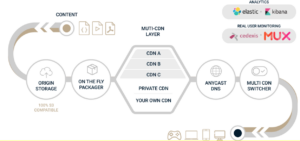Private CDN Between The Present And The Future
What Is The State Of Private CDN Today and What Will It Be Tomorrow?
The world of internet applications has evolved significantly, especially over the last decade. People are spending more significant time than ever before hooked into the internet. According to the Cisco Annual Internet Report, there are 4.57 billion active internet users globally in 2020 which will raise to 5.3 billion internet users by 2023 . Our daily routine without the internet seems hard to imagine today. And the manner of the user-engagements has also become more multifarious, rich, and complex. The rise of cloud-based gaming, Virtual Reality, OTT, high-resolution video streaming, and others have necessitated the evolution of the modern internet infrastructure that can handle the spike in demand while affording a superior performance at all times.
With internet applications and websites becoming so complex, it has put strains on the current infrastructure capabilities. However, the necessity of providing a high performance has perhaps never been more critical. High user engagement can be directly correlated with the loading speed and web performance which for OTT services can mean streaming without buffers. Seamless and fast user experience is also crucial for search engine optimization, and will directly impact your business bottom-line by encouraging users to complete more conversions.
There are certain crucial pieces in this infrastructure that make such a high performance possible—CDNs, 5G network, front-end optimizations, and back-end optimizations.
Today, we are going to cover the current state of CDNs and how they are helping to solve the crucial challenges of seamlessly delivering the demands of the modern web over the internet.
The World of Legacy CDNs
In a traditional sense, a CDN utilizes a network of strategically located and geographically distributed servers to cache content from a website or a web app on these servers. A CDN is so useful in delivering content to end-users with low latency, and this capability yields in CDN’s architecture.
When a user requests for a piece of content, the request then is delivered to the nearest Edge server of the CDN. Thus the request only needs to travel as far as the nearest Edge Server(Cache Server), and back. This way, it significantly reduces the round-trip time(latency), i.e. the time that it takes for the request to get resolved and get rendered in the user’s browser or mobile application. Hence, CDNs provide significant advantages over the traditional hosting set-up.
However, since the CDNs emerged on the scene as a critical piece of infrastructure, the web front-end has evolved drastically. Websites have become extremely code-heavy, and highly interactive with dynamic content, video, and JavaScript to entice and engage the web app or website user.
There has also been an explosion of different device types and the emphasis on ‘last-mile’ connectivity to target a more significant volume of users, who may be located in remote and inaccessible geographical regions.
The State of CDNs Today And What It Means For The Future
The traditional architecture of CDN makes it optimal in scenarios where the majority of the user base is concentrated around a particular geographic area. However, in case your subscriber base is dispersed globally, this architecture might not help you against network congestion and other issues.
Cisco projects that by 2022, CDNs are expected to carry about 72% of global internet traffic, up from 56% in 2017. The subscriber base for OTT providers is proliferating as well and expected to reach 650 million in 2021. With the continued rise in applications such as cloud gaming, OTT streaming services, VRs, ARs, scaling for performance and pricing have emerged crucial in the road ahead.
Because of the enormous volume of data that is being streamed, users’ complaints about sub-optimal UX and poor streaming performances over traditional CDN services, are becoming more and more commonplace. Traditional CDN architecture needs to scale up.
As a result of the shortcomings with a traditional CDN model, many companies have started adopting a multi-CDN approach. However, even with a multi-CDN approach, the cached content is kept on a shared server. This might result in your content battle to survive in a shared server. This can be due to cache replacement algorithms which will try to keep popular contents of other content providers in the cache server and wipe out your less popular content from these shared servers. Therefore this will result in a cache miss as well as streaming latency. As a result the user QoE will suffer dramatically.

Private CDNs for the future?
The legacy CDN infrastructure is not optimized enough to handle the traffic loads of today. Several technologies have emerged today, such as Anycast, Google’s BBR and Docker containers, software-defined networking that give rise to a new era of private CDNs, and promise to transform the older video workflows completely.
Private CDNs can also support use cases to run VM and containers for billing, packaging and data applications at the edge of the network
Some of the clear benefits of adopting Private CDN approach are:
– You can control the delivery quality and analyze performance at a granular level
– Cache size can be customized based on your business model, target geography, and content size.
– You can control the cost of other cloud CDNs in the mix because you will know the real cost of running a CDN
– You will not have to find and employ a tech team experienced in CDN, which is already scarce. You may have to train your existing staff – which is expensive and may reduce your time to market.
Additionally, you can focus on your target region with Managed CDN and still serve other global areas with cloud CDNs.
Modern, intelligent private CDNs can identify images, HTML, JavaScript, etc., and prioritize the data sent to web browsers. With built-in, sophisticated AI and ML systems to identify network bottlenecks and make real-time decisions to re-route the content delivery and storage decisions. It will help the owners proactively identify network traffic patterns and quickly respond to communications traffic demand. As a result of this, the users will experience an improved content performance.
Security is another crucial aspect when it comes to this, apart from performance. Malicious cyber-attacks and DDoS attacks are becoming more frequent today, and they can cause revenue and reputation loss for businesses. Kaspersky recently reported an 84 percent increase in the total number of DDoS attacks. Using a legacy CDN your contents’ security is limited to the tools and options offered by your CDN provider, and you are not able to take extra measures on CDN for this purpose.
Private CDN Solution With Medianova
At Medianova, we provide the full range of optimized private CDN services for your, with an exceptional cache performance; so that you experience minimal latency. With our private CDN benefits, you can customize the configuration & take advantage of your dedicated cache space that will guarantee up to 100% cache hit ratio, while also providing a smooth user experience for all of your users.
With dedicated hardware resources, advanced security in place, dedicated uplink and a fully customizable latency-based Content Delivery Network, you will be set-up for an optimized performance and scalability.
Join us for a webinar hosted by streaming industry expert, Dan Rayburn and Serkan Sevim, CEO of Medianova CDN.
At the webinar, we will share exclusive survey data from the streaming industry and the CDN industry and also illuminate you upon the state of Private CDN between the present and the future.




